In 1955 the Guatemala Government reopened the airfield at Tikal, making possible the initiation of large-scale excavation and reconstruction there. Work was begun in January 1956 when a transport plane of the Guatemala Air Force landed members of the staff and a group of workmen at Tikal. That first season, though some archaeological work was accomplished, was primarily concerned with searching for sub-surface water, bushing, and building camp. During the second season, January – May 1957, the clearing and exploration of the site continued, and mapping and excavation were begun. A tractor, jeeps, and well-drilling equipment were air-lifted into Tikal. One of the main objectives this season was to procure a permanent water supply. It was decided that at least two wells would be needed, but all digging was unsuccessful; meantime, water had to be hauled by tractor from a distant water hole or flown in from Guatemala City. It was decided to clear and deepen the old Maya reservoirs. Reports of the 1956 and 1957 seasons appeared in the University Museum Bulletin for December 1956 and September 1957. In the following pages, extracts from Mr. Shook’s letters and diary carry the Project through the 1958-1961 seasons. Accounts of the archaeological work appear from time to time in Expedition. ~ Editor
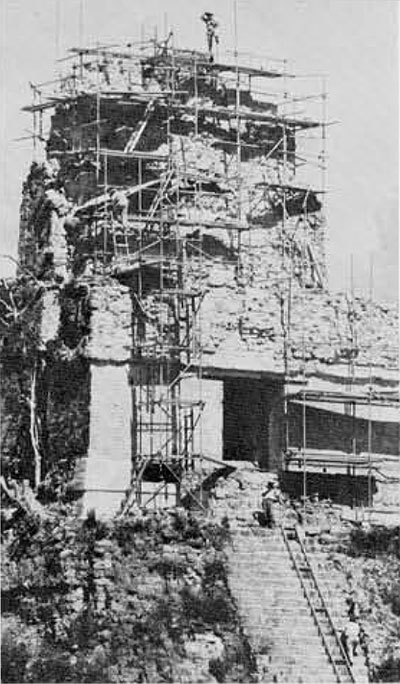
TIKAL, FRIDAY, DECEMBER 20, 1957
Last Wednesday to Tikal. Tono had camp in good shape and accomplished a considerable amount of work since last May. My house and the Penn house (staff dorm) have been floored, plastered, and screened; three new galeras and toilet for workmen, new galera housing the sawmill, and one for the carpentry shop. The sawmill has been operating since September and quite a stack of lumber has been sawed, mostly cedro.
Tono had made a start on his hotel but on his own would not have the hotel facilities ready for the coming field season and one way or another we would be combing tourists out of our hair. With a staff of ten and the visiting firemen, our original kitchen and dining room would be taxed to the limit. So I have decided to take over the building, equipping, and operating of the hotel as part of the Project, to feed the staff there, and use it to house and feed not only Museum friends, but others wishing to spend more than the one day at Tikal. Tono and wife will manage the place and handle tourists, keeping them out of our camp which is apart from the hotel. Tono will pay so much per month on the cost of the buildings and equipment and when the total cost of the Project has been repaid, he owns the hotel.
Examined the aguadas, some have very little water, others are overflowing. There were below normal rains all summer and fall until the past month, and heavy rains then brought up the water. The place was miserable, mud everywhere, a drizzling rain most of the time, and terribly cold…The lack of howler and spider monkeys gave a silence to the jungle that I have never experienced. They died like flies last August and Tono says they were crying and moaning like humans. The skeletons are everywhere through the forests. I talked with the yellow fever experts, and it will require five to eight years for them to come back. There is a rich bird life though, with many birds new to me in the area; they may be migrants wintering or on their way farther south.
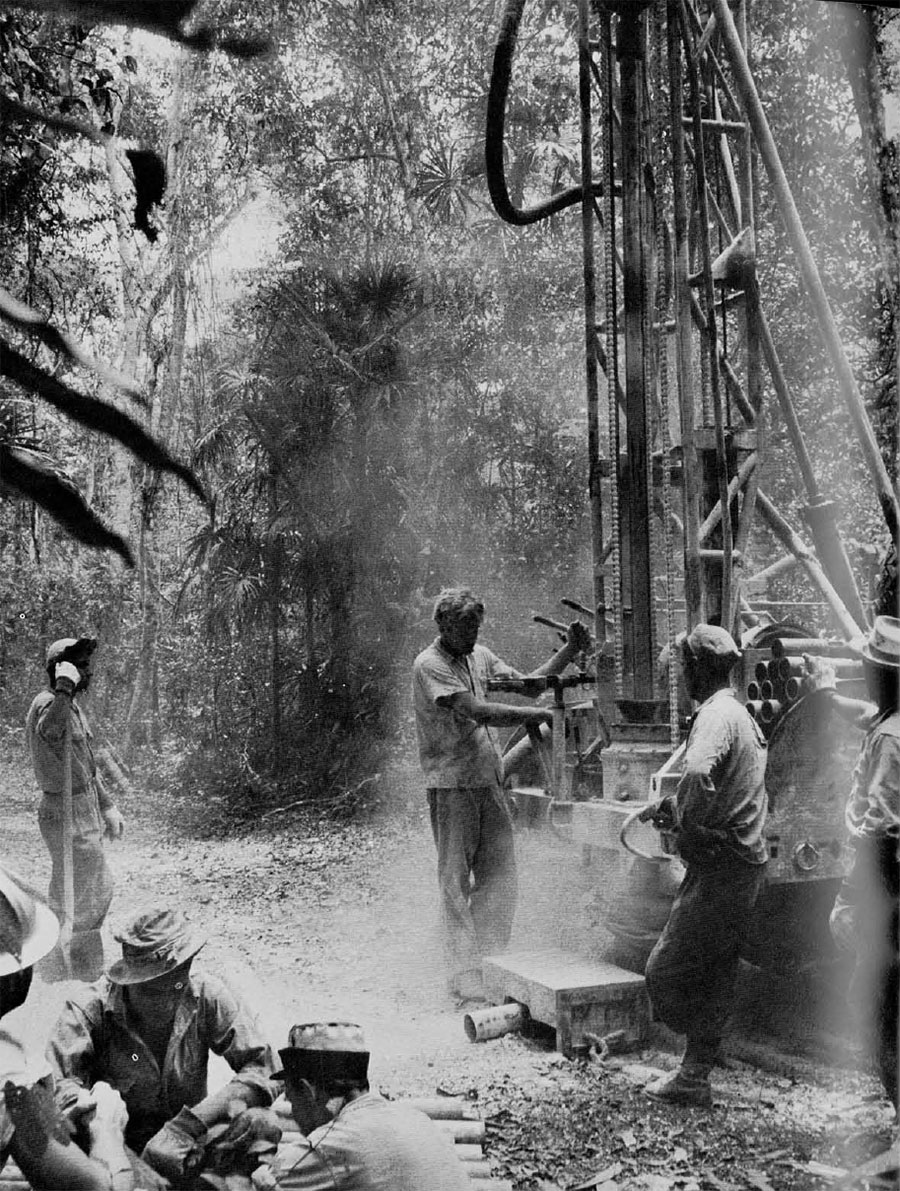
The new Guatemala Government has approved the plans for a Tikal National Park.
DECEMBER 23
The labor problem is acute. All the oil companies are working full force in road building activities and seismographic surveying. Naturally, they are paying better than we are.
DECEMBER 29
Saw the officials of the Bank of London about Smith’s gift to the Tikal Project of sawmill machinery and spoke to a number of potential buyers. This was before I went to see the equipment. I just got back last night and am most depressed about the situation. Briefly, it is located in almost inaccessible sites, has been idle since 1951 and 1952, and is much the worse for lack of maintenance.
In between the sawmill business, interviewing cooks (none come back after I tell them the salary), ordering equipment for the hotel, etc., etc., I have gotten twenty-some letters written.
JANUARY 27
Bert Noble flew me to Puerto Barrios where after one month our supplies finally were delivered to the Aviateca office ready for air shipment to Tikal. A big plane was all ready to take a full shipment of approximately eleven thousand pounds in the same day and I thought our worries were over and we flew on to Tikal. Had all the men ready to unload–finally at 5 P.M. , a DC-3 came in with six thousand pounds. The big plane was being loaded in Barrios and one of the loading trucks ran into the plane’s landing gear! So we still lack a lot of stuff in our shipment. But the work progresses. Bert Noble yesterday got the first stela re-erected. We all were on hand for the big event–the first repair work at Tikal, two years almost to a day from the date we landed in 1956. When you see the roads, clearing, and field camp, and think it is only two years, it is a bit startling.
FEBRUARY 5
We are going full blast and there isn’t time for everything. The place is crawling with workmen, carpenters, and staff, as well as tourists. One job is held up for lack of screen tacks, another because the tractor has a flat tire, another for lack of cement, and so it goes. We shift and improvise, and Aviateca hasn’t brought our equipment in from BArrios… The aguada water drops at an alarming pace.
FRIDAY, FEBRUARY 14
Some of the supplies, including the water pump, arrived from Barrios on the 8th, the rest on the 12th. We immediately began pumping from the large area of the reservoir into the smaller deep section cleaned last year. Pumped nine hours on Saturday and Sunday and got an estimated fifty thousand gallons of water into the reduced area where we calculate the same amount was held. This approximate one hundred thousand gallons we hope will last well into the dry season, and we are using a chemical on the surface to cut down evaporation. The empty side of the reservoir was crawling with shrimp, tadpoles, and an assortment of wild life. The birds had a feast on the shrimp and tadpoles. How the shrimp got in the reservoir after it had been dry as a bone, cleaned and excavated last spring, is a mystery.
FEBRUARY 18
Had just written C.L. Lundell, Director of the Texas Research Foundation, in reply to an inquiry from him about the possibility of making a detailed study of the flora of Tikal, that one of our principal aims is to encourage co-operative research in all of the natural sciences which may throw some light on the habitat of the Maya. Our work to date has been opening trails, a few roads, and cleaning several of the principal buildings. The flora of the site really has been untouched. The total disturbed area other than the air strip may amount to ten acres or so out of the estimated sixteen square kilometers which we are mapping as the metropolitan area of Tikal. Aside from this, the Guatemala Government has established a national park of 576 square kilometers surrounding the archaeological site. The area includes bajos, aguadas, ravines, slopes, and ridges, each with its particular vegetation type. We will be delighted to have Dr. Lundell and his organization assume responsibility for the botanical problem…That was an easy decision to make. So was the decision not to take on a tourist who thought he would like to do ceramic work but was about as prepared as one of our chicleros. IT is the occasional person whose work is poor or the one whose work is good but who is temperamentally unfitted for camp life that makes a field director’s life a misery.
Fired one of the men’s cooks–a floozie from Flores–sounded good but she wasn’t. Have fifty to sixty men (I never know as they drift in and drift out–some on their own and some helped on their way) to feed with one cook. Had to put the tortilla grinder in the kitchen, take one of the workmen and put him on the molina. Expect another female, highly recommended, tomorrow.
Vivian Broman works like a trojan and so does Jane Adams, seeing and doing things without being asked. There always is more work to be done than can be handled by a few willing people. Bill Coe and Dick Adams keep busy all the time.
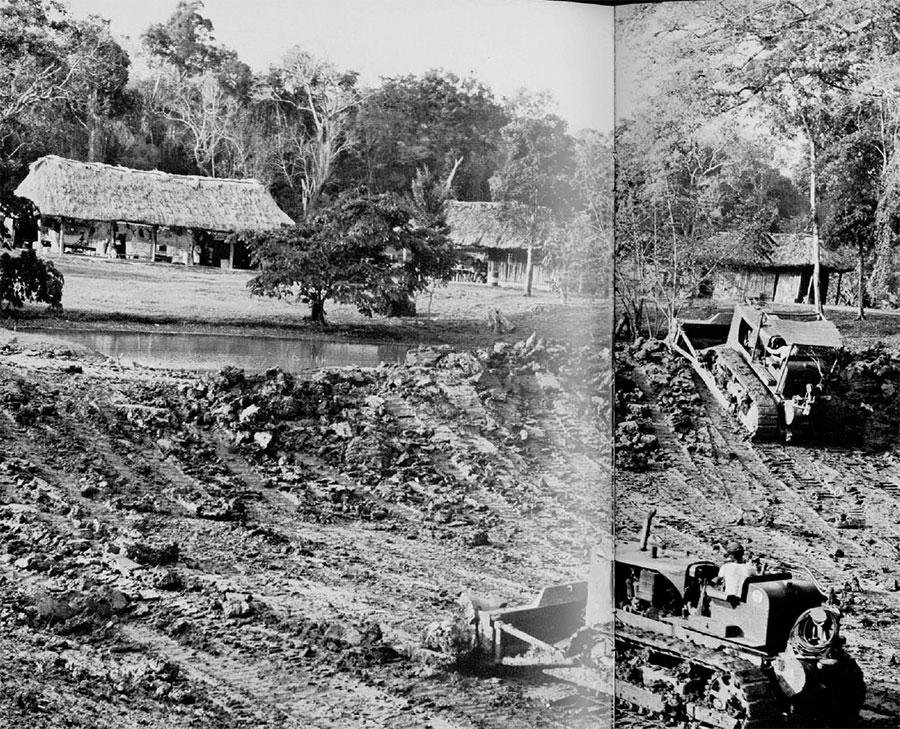
FEBRUARY 24
The Museum has made an agreement with Life Magazine; should give us excellent publicity…The work progresses; expect to make a good beginning this season on Temple I or II or any of the North Acropolis temples. The main probing and solidification will have to follow in 1960 and ’61. We lack the scaffolding to work on these great heights but if the money were available, it could be purchased and shipped this summer and fall. Will look into this when I am in Philadelphia… The Esso people are moving in this week with tractors. We have the area cleared and ready for the tractors at the far end of the airfield where John Dimick suggested we dig a deep reservoir to catch the drainage from the airfield. We expect this coming rainy season will amply justify his brilliant suggestion. Also plan to deepen the camp reservoir, and, if possible, dam the Naranjo ravine ..We are now faced with the backdirt moving problem. The tractor and trailer have been handling it from the Main Plaza to our dump about 150 meters away. This is not efficient. I have decided to build an earth hopper on the spot from our sawed lumber. The hopper top will look like an inverted truncated pyramid. Men with wheelbarrows carry the dirt out on a runway and dump into the hopper bin; when full, a truck drives under, a trap door is sprung, and the dirt spills into the truck and is hauled to the dump.
MARCH 15
Had to go into Guatemala City last Friday because the Esso Oil Company received orders to cut back their operations. They wasted no time in canceling the contracts with the tractor operators and seismographic drilling company. The tractors and drilling equipment were to be immediately removed to Belize and shipped back to Texas and Guatemala City. It required a prolonged session with Walt Spangler in Guatemala City to persuade him to allow the tractors to deepen our reservoirs and open another. He finally came around and promised us this work and some drilling before removing the equipment. They are also helping us by occasionally hauling in a tank load of water from Lake Peten.
I discussed the Maya Art SHow with Carlos Samayoa Chinchilla, Tono Tejeda, and Gus Stahl. They are all enthusiastic about it and the climate is right for official permission from the Government. Stahl tells me that Richardson from the Detroit Museum will be coming down soon.
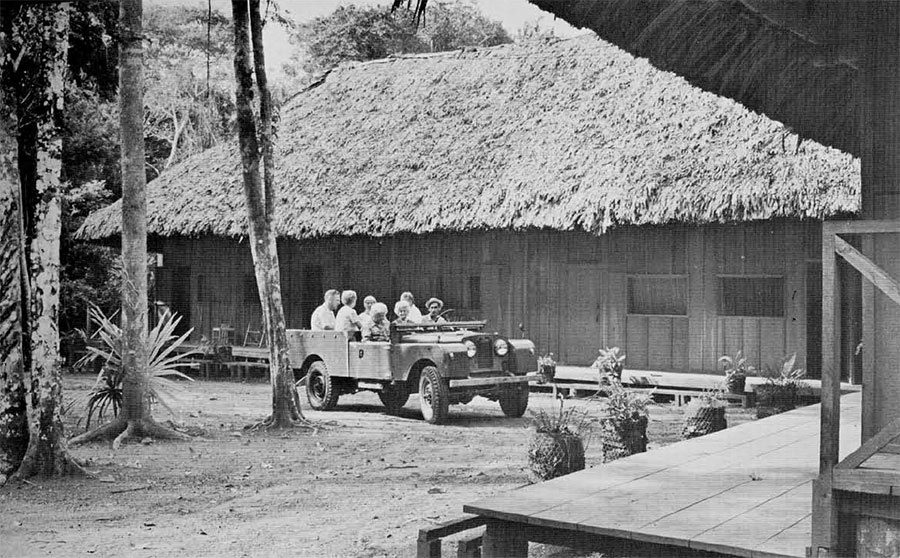
MARCH 18
Last night I received a radio message from the bank manager in Guatemala saying there has been a firm offer of $5,000 for the sawmill equipment. I am sending a message tonight accepting and will have to go to the city again when the papers are drawn up.
APRIL 2
The Esso Standard Oil Co. and Petty Geophysical Co. descended on us, set up camp by the airfield, and the place looked like a motor depot until yesterday when the last man, truck, and helicopter left. While they were here, we got a new reservoir excavated by the far end of the airfield, the one at camp dug into four deep holes, and the drainage channels opened. They drilled us a well, 318 feet deep, in a ravine near the Naranjo Aguada, but found no water. We all had rides over the ruins by helicopter.
Life Magazine landed in force March 26th with Charles (Chuck) Elliot as writer, Fritz Goro as photographer, and Alton Toby, artist. They do their job thoroughly and I have been photographed in every position… Never have I seen so much film exposed, both in color and black and white. They are good fellows, but inevitably take a lot of our time answering questions, and going through the mechanism of working while Fritz clicks a camera in our faces. Now I know how the Maya feel at Chichicastenango!
APRIL 11
Five months have taken their toll and recently the heat every day has sapped all of us. Many of the men have quit, the staff has had a rash of infections, stomach upsets, etc. Fernando Aldano (M.D.) and A.V. Kidder came in Wednesday and Ferd checked over the men and staff, but I forgot to have him give me a check, he was so busy with everyone…We are now girding ourselves for a mob scene next Tuesday–the new President of Guatemala, his ministers and officials, the new American Ambassador, Lester Mallory, a total of thirty-five to fifty people. Radio messages are flying back and forth.
TUESDAY MORNING, APRIL 15
Am sitting awaiting the President and his party. We are brushed and scrubbed, having worked right through Sunday, ten hours a day, to spruce up the dig, campe, etc. It does look lovely. The camp has clean, green grass over the slopes, white plaster thatch houses on the ridge, all against the deep green of the jungle…Here comes a plane.
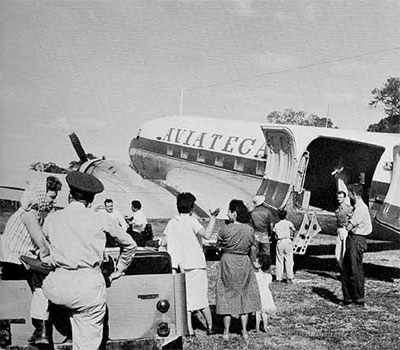
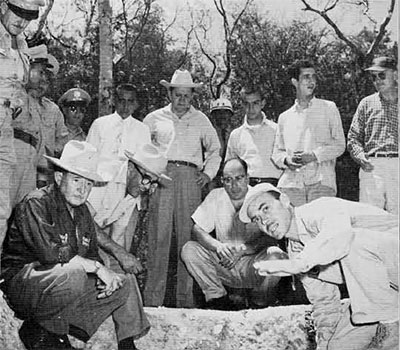
WEDNESDAY
That is over and what a day! The first plane landed with newspaper reporters and sundry guests and officials. The second plane with more of the same; the third plane (U.S. Air Force) had the President, Dr. Mariano Lopez Jerrarte (Minister of Sanidad Publica), the President of Congress, deputados, the American Ambassador and several of his official family. A total of fifty. Much confusion. Photographers working overtime. Finally we got the caravan going. I drove Tono’s Landrover with the President and Mallory and eight or ten others with a machine gun! Bill Coe drove the big jeep; and the huge International stake-bodied truck I had purchased from the Petty Co. and which arrived just in time, carried most of the remainder of the party. Our little jeep had Fritz Goro, the photographer for Life. There must have been twenty cameras, black and white, color, and movie, going madly all day. We showed them the works–ruins, camp, hotel, etc., then fed all a cold buffet lunch in the Posada de la Selva. Must admit it was a grand lunch, the U.S. Embassy crashed through with lettuce, celery, tomatoes, a beautiful ham, cold beer, etc. This with potato salad, cold meats, etc. made a proper lunch on a hot day…I honestly feel we did our best yesterday and now have to see what effects our efforts made on the new government. We were exhausted when they all pulled out about 3:30 P.M. Had given men and staff the afternoon off to see the show.
Just after dinner last night, a storm hit, and everyone, stripped to pants, went out like wild men bathing under the roof eaves, collecting water in every container; and quite a bit collected in the reservoir. This morning we are pumping the pools into one, and have saved quite a bit of water.
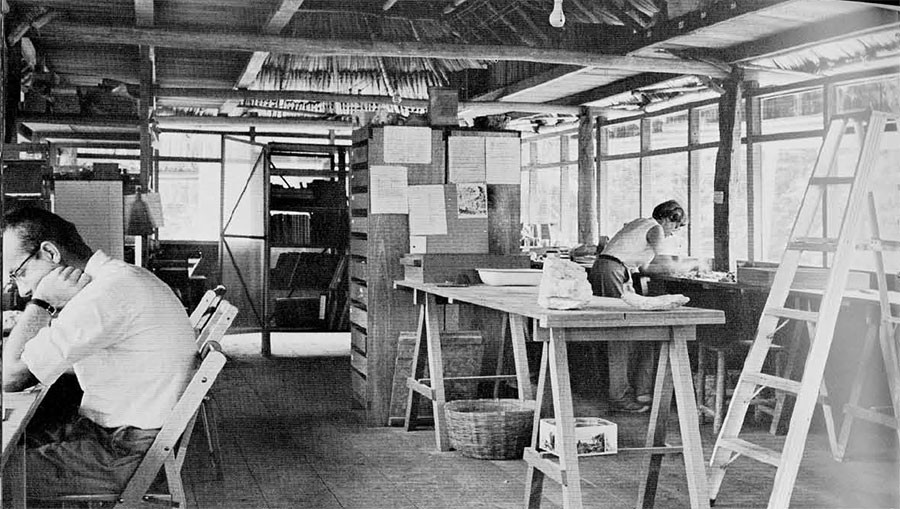
HARVARD, MASS., MAY 29
Dick Adams, whom I left in charge of camp during the summer, writes that the first hard rains of the season came on the night of the fourteenth and the reservoir drainage systems worked fine. Aubrey Trik will take over in September.
TIKAL, JANUARY 23, 1959
Trik had camp in excellent shape on my arrival. Most of the labo went out for the Christmas holidays but has been trickling back in since January 15. We are up to about thirty men and cannot employ more until the rains, which have persisted, let up. As soon as the weather clears, we will double the number of men, including masons, and get the repair work under way. In the meantime, two more family housing units are being erected (families arrive before the roofs can be put on!), lime is being burned for repair work, and camp and laboratory put in operating condition for a full schedule of excavation, repairs, mapping.
The Government has elaborate plans for the development of the National Park this year. We are assisting as much as possible. Something concrete should come out of the proposals in 1959…Aviateca has established regular air service three times weekly, Mondays, Wednesdays, and Fridays, to handle the increased flow of traffic to Tikal. Also special excursion planes, one, two, or more, arrive each Sunday. Fortunately the hotel is functioning well and we are almost free of the tourist problem.
FEBRUARY 2
Our large shipment from Barrios was coming in by cargo plane last week and on the third trip the huge plane missed the center of the runway and crashed in the soft shoulder. Fortunately the heavy mud absorbed the shock so that crew and cargo were undamaged and the plane can be repaired here. We have given all assistance possible to Aviateca to recover the plane and it is now moved free of the airstrip and placed on the side awaiting a new wing-tip and central motor. We recovered undamaged the entire cargo which makes a total of thirty thousand pounds received from Barrios. We are using every effort to get Aviateca to fly in the remaining fifteen thousand pounds as promptly as possible.
SATURDAY, FEBRUARY 14
To the insurance company to get forms, etc. so we can take out accident insurance for the Tikal staff.
MARCH 6
The cargo plane was fully repaired in three weeks and was flown to Guatemala City. No more accidents, as the field is hard and dry. The hot weather is on us, but not too tough so far. Plenty of water in the tanks and reservoirs assures us of no water problem this season.
SUNDAY, APRIL 12
Yesterday had the annual Men’s Party and it seemed to be a howling success. The number of people in camp reaches about 125 including women and about thirty-five children. Had a pinata for them. Little Ixcopal isn’t with us this year, but several old faithfuls, Pancho Avila and Ramon Lopez, Nestor Herrera, etc. are still around.
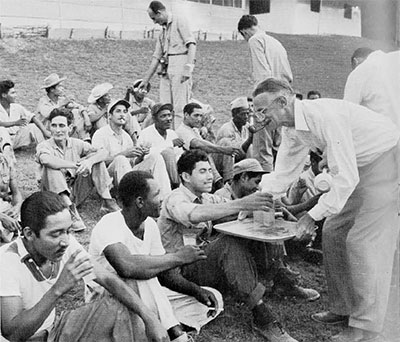
APRIL 20
I have arranged with Stuart Scott to continue working through August 1 and Bob Carr, September 1. Am in a quandary as to who should be left in charge of this huge operation of seventy Guatemalan workmen and a mass of their women and children. as soon as Aubrey returns I can feel assured whatever comes up will be properly handled.
MAY 7
We have finally delivered the well-rig to the Guatemala Government and all paper work is done. The sale price was $12,000.
HARVARD, MASS., JUNE 10
Finally decided to put Bob Carr in charge until Trik arrives at Tikal in July. Two reports, together with accounts, from him so far. Archaeological and reconstruction work going along well and he has gone ahead with the screening of the lab, cleaning of the water tanks, and general repair. But there are ever the problems with the workmen. In the first report, he says that the two masons living together had a squabble (including the wives) so violent that they can’t continue living together in the same house. “You can’t call my children thieves!” “That $5 didn’t get up and walk away.” He has put them up temporarily in the private rooms but is doubtful that they’ll make up and live together again, though one never knows. Perhaps building a couple of real double houses, with separate entrances and all, is a good idea for these small families and preferable to just doubling up two families in one regular house. Then in the second report Carr says that the fighting masons seem to have settled down to an armed truce at least. Santiago de Leon wants electricity in his house–“We have the wire and it would only take a little bit from Max’s house to his,” etc. etc. Have written Carr that we have no plans at the present time for providing electricity. We cannot provide power for one house and no others. The reason for wiring Max’s house was that he is responsible for the operations of the power plant.
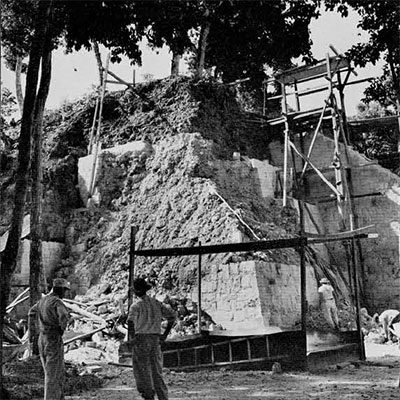
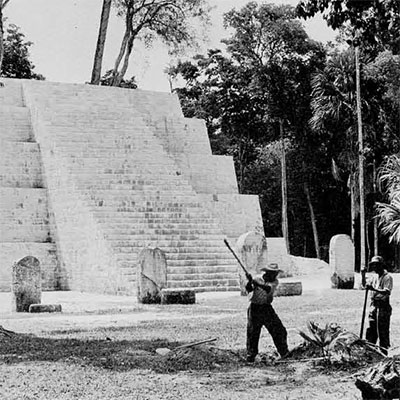
HARVARD, JULY
In his report for May 26 through June 18, Carr says disagreements among the men, particularly the masons, continue…The inside of the limekiln is getting worse and worse as the fire bricks and clay used just don’t stand up to the heat that develops. Since we will probably have an indefinite use for it, it would be wort while to fix it up right with a high temperature lining…We’re now using four men just cutting stone, that is, quarrying. They very laboriously cut out (break out, actually) each block, because they lack the proper tools for splitting the stone. The mason says he needs very thick, large chisels for splitting such soft stone. There must be a more efficient way than we are now using…The DDT team came Saturday, May 30th, and took a couple of days spraying all the building…Tono is ambitiously constructing a lounge–a sala y bar…Carr hasn’t opened any aguada drains except as little as necessary to carry the water away from the buildings and road; also hasn’t cleared any of the watershed slope as he doesn’t think it is really necessary at all, just encourages erosion and silting up of the aguada. The aguada is already as full as it was at the end of the last wet season, and the rains are just beginning. If we encourage it too much we may all be flooded out. He is quite right; we spent so long without water that I have a phobia about collecting water…Problem with masons sounds like the usual business-dishonesty, lies, favorites; they never seem to appreciate a good deal. We had hopes of one man among our masons being a reliable head mason who could assume responsibility and handle men; however, if Santiago isn’t our man, there is no reason to keep him in Tikal.
In this June, 18th report, Carr said that the reconstruction work was coming along, but on June 20th he wrote: “After last night’s downpour we found most all the masonry to the north of the stairs of Structure 78 completely collapsed this morning. The masonry just slid down off the earth core. Worked all day trying to save what was left by shoring, false walls, and filing above to shunt off water, etc.,; but after another terrific downpour this afternoon, we all had an exciting view of half the stair collapsing. Luckily, no one was hurt. Half the stair and the masonry to the south of it are still intact, but after watching today’s slide, I’m really afraid it’s all going to fall no matter what we do…I foolishly put my trust in the head mason and assumed that he knew what he was about…a good bit of the actual masonry work was not well done. It looked good outside, but was poorly bonded, and poorly backfilled…The sections that still stand are those built by the Monterroso brothers and Pedro Yat– it’s ironic that the best masonry was put up by these men who are not even paid as masons! Stuart took pictures showing all the sickening details.”
But on June 28th he wrote that he wasn’t so sure that the part built by the Monterrosos is doomed; it is still up and looks the same; also, Enrique and Mercedes swear there is no dirt behind it, that they dug back to stone for each tier, and used only mortar and layed stone for backfill, plus using bigger, heavier stones in front. Naturally they’re pretty cocky now, since they’d been having a quiet feud with Santiago from practically the beginning. Though they believe what they say, we will have to dig along the side to investigate whether it is safe to add onto or not.
This failure of our first repair job at Tikal is a bitter blow, but it could have been infinitely worse if anyone had been injured. And it is well that the failure was on Structure 78 rather than on Temple I. We have learned a hard lesson.
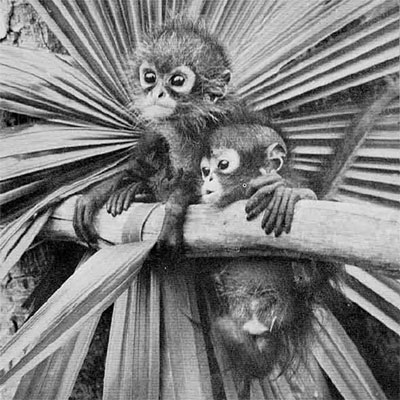
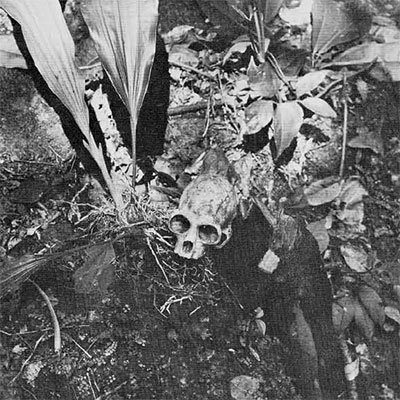
HARVARD, JULY 15
Another report from Bob Carr. (I needn’t have worried about putting him in charge; he has done a fine job.) The Monterroso brothers with four helpers are working on 78, just consolidation of the core above for the time being, until Trik arrives and can make a proper appraisal; the reconstruction work is his responsibility…Tono has finished thatching his sala and bar and has opened up a nice dry road to a “guanal” big enough for all of our thatch too…Post holes are dug for the first two houses…A dozen fruit trees which had been flooded by the rising aguada have been moved to higher ground; may have to move more later.
TIKAL, JANURAY 25, 1960
Arrived on the eighth and found the camp in good shape. Most of the workmen were still out on their leaves and have been coming back steadily. We now have sixty workmen on the job and another eight coming in this week. Still short of masons. The general plan is for around seventy-five men for the spring season…It has been miserably cold…The FYDEP (Guatemala Government agency) promised soon to have two or three provisional buildings sent in: one for the museum, one for the part administrator, and one for the guardianes.
FEBRUARY 1
With seventy men and staff members I have been on the go. Aubrey is busy–the repair work is a laborious, slow job and we cannot find good masons…Mary Ricketson and Hattula Moholy-Nagy have the lab in excellent shape, both doing a fine job cheerfully and effectively under Vivian’s supervision. Mose has camp looking like a park. The village still is kept neat and looks like one big nursery! I have hesitated to take a census, afraid the number of people per house would be too much of a shock. There are nine families and their innumerable relatives installed with three more houses available.
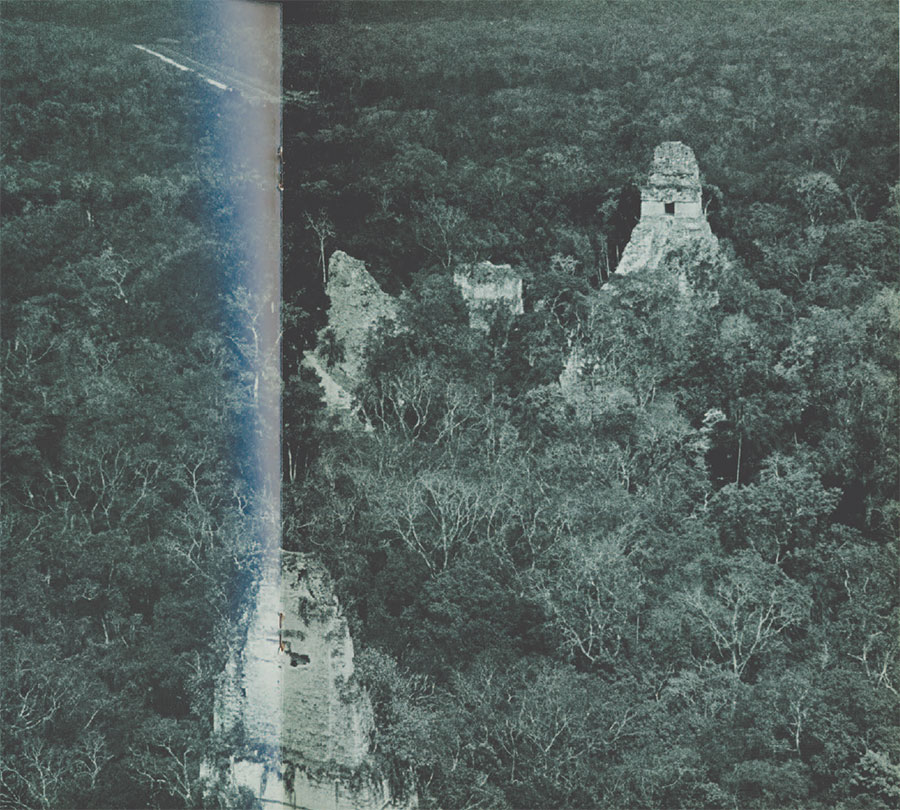
FEBRUARY 25
Three new masons came in several weeks ago and the accelerated repair in E Group is quite noticeable. Structure 78 probably has about two more weeks of masonry work to complete it. Another group of men are repairing the Stela 22 Enclosure…Lundell is here for his second season of study on the plant life…There have been an increasing number of visitors and right now there is a TV photographer sent in by the Guatemalan Tourist Bureau and FYDEP.
FEBRUARY 29
On Saturday, the 20th, three plane loads arrived with 32,000 pounds of general camp supplies. We did well this year, unloaded each plane in twenty to twenty-five minutes and had the cargo under cover by the time the next plane came in. Another plane load of 12,000 pounds arrived this past Friday, leaving only 521 pounds of this year’s shipment still at Barrios. In all, 44,000 pounds, which includes everything from medicine, office supplies, and food to a huge hoist, hydraulic trailer, digging tools…Bob Carr, Eduardo Martinez, and Hans Gregersen continue the mapping efficiently and with enthusiasm. They are my proudest operation and require the minimum or supervision.
MARCH 15
The hydraulic trailer is a joy. As Dimick predicted when he suggested it, it handles the dirt problem and keeps the backdirt moving with fewer men and less interference with pile-ups…The arrival of the hoist now gives Aubrey a means of getting materials up and down from the Temple I roof-comb. I must admit I shudder when I see the men crawling around the scaffolding and the condition of the roof-comb. Aubrey’s approach is careful and sow, but it will be a fine job. It is a most delicate and dangerous operation.
MARCH 23
Our clinic opened on the fourteenth, the first public school at Tikal on the seventeenth. They have created much good will among the labor force. Now we have had a rash of requests for hosuing as more and more wish to bring their families to stay at Tikal. The Project provides the building and the school teacher, who also serves as the practicante (probably comparable to a trained male nurse). The workmen themselves paid for the furnishings of the school building (desk, benches, tables) and school supplies. They will also maintain the grounds and the building, so we’re developing a bit of civic pride among them which is quite new to their way of life. The clinic is simple, with a medicine cabinet, examining table, desk, and a few chairs. Some of the equipment was supplied by FYDEP and the medicines by the Instituto de Seguridad Social. The clinic is open at regular hours during the day for everyone in Tikal, including the staff. This relieves pressure on the staff doling out aspirins, bandaids, etc….It was really a thrilling sight to see the scrubbed and bright-eyed youngsters grouped around the school by seven o’clock in the morning, waiting for it to open at eight.
Noble also suggested that a small compressor, or possibly a commercial type of vacuum cleaner, would produce enough air pressure to blow out the dirt and soft mortar from around the stones of the destroyed facade of the roof-comb, thus saving much hand work and time as well as doing a better job. We’re also going to look into some Gunite type of equipment to inject the mortar. This will speed up operations bu the reconstruction is bound to be a long, arduous, expensive part of the Project.

APRIL 2
Among the constant stream of visitors, right now we have six Guatemalan artists on a mad painting spree. They’re joyously slapping paint on canvas and paper for a big Tikal art show to be presented in Guatemala City after their week or ten days’ effort here.
APRIL 21
Dr. McConnell from the Gorgas Laboratory in Panama was here a week collecting sand-flies which are the cause of chiclero ulcer. He also took cultures of all the cases in camp and photographed the individuals for comparative data on the types prevalent in this area. We’re making a concerted effort with the help of the Seguridad Social to treat and clear up this rather common ailment among the workmen.
No problem this year about the summer field director. Bill Coe, who has been in Philadelphia since February, will be coming down next month. He will be in charge through August and can be depended on to do a good job. As usual, Trik will be here through the fall.
TIKAL, WEDNESDAY, JANUARY 18, 1961
Arrived in Guatemala January 12th and spent several hectic days seeing Government official. Don Inocencio del Busto again generously lent me his car for the innumerable last minute chores. Saturday morning I picked up Aubrey’s glasses at the Marquesa, $2,000 in cash from the bank, called at the Archaeological Museum, etc. and delivered the car to Del Busto’s home. The briefcase with the Tikal payroll money, Aubrey’s glasses, packages, etc. were locked in the car for a few minutes while I waited in Don Inocencio’s house for him to drive me back to the hotel. We started out and noticed the right front door of [text is cut off] payroll money.
Phil Leonard, our Guatemala City agent for the past five years, plans to leave soon to raise chickens in Lebanon–a great loss to the Project.
On Monday, Dr. Charles W. Goff, Hattula Moholy-Nagy, and I flew into camp. Goff–in to study Tikal skeletons–told us of his extraordinary quest for the shattered fragments of Christopher Columbus’ bones. Aubrey Trik and Bill Haviland on hand. Camp very wet, it still rains and rains. Even the reservoir is on the verge of overflowing and everything is soggy–including us. There has been no let-up since last fall. All envelopes are stuck together, the books are in dreadful shape with green mold, and our beds are cold and damp every night. Except for some discomfort, camp is a beautiful lush green, the jungle really looks like a tropical jungle, and the crocodile is disgustingly fat, particularly today, having just eaten the only Great Blue Heron to land in the reservoir area this season.
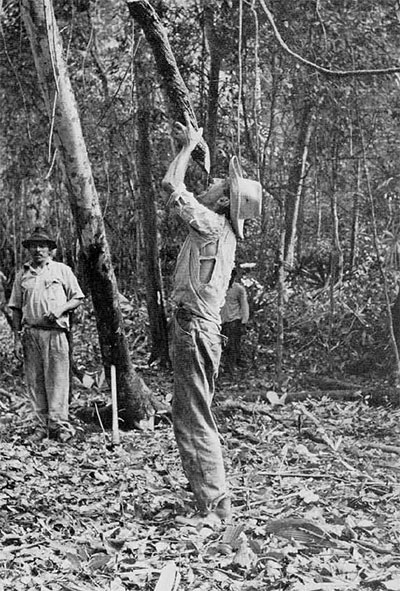
JANUARY 25
Staff slowly arriving. Bill Haviland, between rains, is digging housemounds, Hattula studying artifacts in the lab, Goff, in five days, studied all the human skeletons we have recovered to date, Trik is repairing the Great Temple I, and I am on the North Acropolis excavations.
FEBRUARY 8
The past ten days have been a three-ring circus with persistent bad weather, workmen and staff pouring in, V.I.P.’s and tourists in droves. Fro Rainey, Ted and Mary Kidder, John and Teena Dimick, Alice Tully, and three fellows from the Rockefeller Foundation thoroughly inspected the operations and the plans and objectives of the Tikal Project.
FEBRUARY 22
Lost several work days from continual rains up to February 15. A depressing tropical drizzle went on and on, soaking everything and turning camp and the ruins into a muddy mire. All the staff and the workmen’s children in camp had a glorious treat when Bill Rich and Hal Ball flew in from Miami in their private plane, bringing gallons of ice cream!
On the 10th and 11th, Bill and Hal took Aubrey and me on extensive archaeological exploration flights over much of the Peten. We flew over the very large ruins northwest of Uaxactun, first seen from the air by Percy C. Madeira, Jr. and Alden Mason back in 1931, and spotted a number of new, unreported sites.
Ted Kidder and I went out on the 15th. Phil Leonard met us at the Guatemala City airport with the charming news that one high official in the Ministry of Education refused to sign our franchise or to permit our annual shipment of supplies into the country duty-free. The same official stated, despite five years in operation, that the Tikal contract was illegal because Congress had not passed it, that a decree signed by the president and ministers of the Government was not sufficient. Phil also reported that through someone’s boner, the whole shipment of Tikal supplies had to be freighted by rail from Puerto Barrios to Guatemala City and tied up in the Aduana Central.
Urgent call by FYDEP for Tikal material and photos to fill their exhibit at the annual Spring Fair opening March 11th. We settled for enlarged photographs. Finally spring loose the repaired Tikal radio receiver and transmitter from official red tape. We now have radio communication after five months without it.
Lic. Adolfo Molina, Ted Kidder, and I warmed benches for hours in Government offices trying to unlock the camp supply shipment. Failed to get an interview with the president, so sent a telegram.
On February 16th had the last meeting before the big show Friday evening of the hard-working committee for the construction of a Tikal museum. Everyone tense, worrying about the lecture, lights, sound, the number of people who might attend, and so forth. An awesome amount of preparation had been made and 818 admissions sold, at a dollar each.
The Friday, February 17th lecture on Tikal evidently successful. Attendance between 500 and 600. A total of about $1,100 raised towards the construction of a museum at Tikal. Lionel Stein officiated, Lic. Adolfo Molina gave an introduction in Spanish, and I lectured in English using color slides of Joya Hairs and Lionel Stein. Baysis Hempstead, the Committee president, gave a gay post-mortem party.
MARCH 3
Trik and I went to flores to appear before the Labor Court. Men laid off last year presenting exorbitant claims against the Project. Case to be decided by judge of Labor Court.
Helen Webster doing a fine job of taking care of the swarms of visitors and interesting them in supporting the Project.
MARCH 22
The supply shipment, after two months’ delay, began arriving the 14th. Still 5,000 lbs. missing.
More visitors: Bob Dyson from the Museum, and today A.V. Kidder and Barbara Aldana. Their arrival cheered us immensely. They were impressed by the work and the new Painted Tomb.
APRIL 7
Mr. Sydney Martin, Linton Satterthwaite, and Richard Linington arrived. Linton to study the new inscriptions discovered since 1959, and Richard to test Tikal archaeology with geophysical instruments, using a resistivity apparatus and a proton magnetometer.
APRIL 11
Radio message received the 7th announced the visit on Sunday, April 9th, of the President of Guatemala, the Governor of the Peten, other officials, and guests of the President. Four plane loads descended and all Project vehicles were required to transport the large group. Toured the ruins, banqueted in the garden of the Jungle Lodge, inspected the University Museum camp and laboratories. The President announced that the Guatemala Government would increase its financial assistance to the Project starting in May.
APRIL 12
Today an official arrived to investigate the additional expenditure offered last Sunday by the PResident–only he had been informed that the University Museum would provide the funds! The Tikal Park administrator, Rafael Morales, helped dispel this hope and pointed out the need of living quarters for park guards and their families.
APRIL 26
Back to camp after a frustrating attempt to obtain renewal of the Tikal contract. The Cuban fiasco had Government officials occupied with more urgent affairs than an archaeological dig. Just escaped by a few minutes being caught in the wild street shootings between Anti- and Pro-Castro groups in the center of the city. Several bystanders were killed and many woulded.
Interviewed a young Guatemala engineer, Alfonso Mora, who will come with the Project May 1st as Trik’s assistant on the repair program.
APRIL 29
Today had the annual party for the workmen and their families. Not so many as last year, but scads of children. We had apple-bobbing, balloons, candy, and Pepsi-Cola for the youngsters, sack and potato races, a soccer game, a greased pole, and beer for the men.
MAY 1
A Canadian movie outfit has been here filming for several days. All are French except the heroine–a voluptuous dark-skinned, black-haired girl who curves in all directions and wiggles everything. For Latin color, she poses as Mexican, but speaks with a Brooklyn accent!
MAY 5
Heat is on–temperatures of 90 to 100 degrees most days. Everyone straining to wind up the season’s work. Tempers frayed, labor problems, and trouble controlling boot-legging and sale of “guaro” among workmen.
MAY 10
Six men down with what appears to be malaria–fevers to 105 degrees and chills. Two staff members, Bill Haviland and Dennis Puleston, with severe bouts sent out for treatment in Guatemala City.
JUNE 20
Contract renewed between University Museum and the Government of Guatemala for another five years: January 1, 1962 to December 31, 1966.
